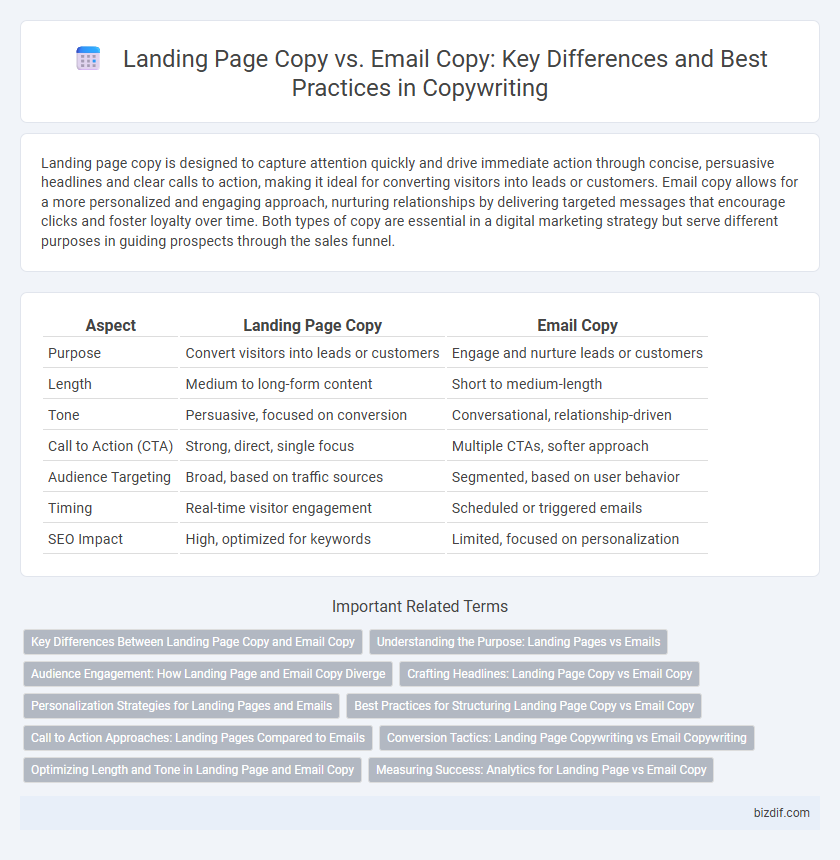Landing page copy is designed to capture attention quickly and drive immediate action through concise, persuasive headlines and clear calls to action, making it ideal for converting visitors into leads or customers. Email copy allows for a more personalized and engaging approach, nurturing relationships by delivering targeted messages that encourage clicks and foster loyalty over time. Both types of copy are essential in a digital marketing strategy but serve different purposes in guiding prospects through the sales funnel.
Table of Comparison
| Aspect | Landing Page Copy | Email Copy |
|---|---|---|
| Purpose | Convert visitors into leads or customers | Engage and nurture leads or customers |
| Length | Medium to long-form content | Short to medium-length |
| Tone | Persuasive, focused on conversion | Conversational, relationship-driven |
| Call to Action (CTA) | Strong, direct, single focus | Multiple CTAs, softer approach |
| Audience Targeting | Broad, based on traffic sources | Segmented, based on user behavior |
| Timing | Real-time visitor engagement | Scheduled or triggered emails |
| SEO Impact | High, optimized for keywords | Limited, focused on personalization |
Key Differences Between Landing Page Copy and Email Copy
Landing page copy is designed to drive immediate actions with concise, persuasive messaging tailored to specific offers, often incorporating clear calls-to-action (CTAs) and visual elements to boost conversions. Email copy focuses on personalized communication, nurturing leads through storytelling, engaging subject lines, and segmented content to build relationships over time. While landing pages emphasize clarity and urgency, email copy excels in maintaining ongoing engagement and fostering trust.
Understanding the Purpose: Landing Pages vs Emails
Landing page copy is designed to drive immediate action by focusing on clear, persuasive calls-to-action that convert visitors into leads or customers. Email copy aims to build relationships and nurture leads through personalized content and engaging storytelling while guiding recipients toward a gradual decision. Understanding these distinct purposes helps optimize messaging strategies for higher conversion rates in both mediums.
Audience Engagement: How Landing Page and Email Copy Diverge
Landing page copy uses concise headlines and clear calls-to-action to immediately capture visitor attention and drive conversions, targeting a broad audience with varied intent. Email copy personalizes messages with segmentation and dynamic content to foster a one-on-one connection, aiming to nurture relationships and encourage repeat engagement. The primary divergence lies in landing pages prioritizing instant engagement for new visitors, while emails focus on sustained interaction through tailored storytelling.
Crafting Headlines: Landing Page Copy vs Email Copy
Crafting headlines for landing page copy demands concise, attention-grabbing phrases that immediately convey the value proposition and drive conversions. Email copy headlines prioritize personalization and curiosity to increase open rates and engagement within a limited subject line space. Effective headline strategies leverage A/B testing and audience segmentation for both landing pages and email campaigns to optimize performance.
Personalization Strategies for Landing Pages and Emails
Personalization strategies for landing pages leverage user data such as location, browsing behavior, and purchase history to deliver dynamic content that increases engagement and conversion rates. In email copy, segmentation and tailored messaging based on user preferences and past interactions enhance relevance and drive higher open and click-through rates. Effective personalization in both formats relies on integrating advanced analytics and AI-driven tools to create a seamless, user-centric experience.
Best Practices for Structuring Landing Page Copy vs Email Copy
Effective landing page copy prioritizes clarity and concise value propositions, emphasizing strong headlines, compelling calls-to-action, and visually scannable content to drive conversions. Email copy benefits from personalization, engaging storytelling, and a clear, direct call-to-action tailored to segmented audiences for higher open and click-through rates. Structuring landing pages around user intent with minimal distractions contrasts with email copy's need for a conversational tone and relevance to nurture leads and build long-term relationships.
Call to Action Approaches: Landing Pages Compared to Emails
Landing page copy emphasizes clear, bold calls to action (CTAs) designed to drive immediate user engagement, often using prominent buttons and strong visual cues to encourage conversions. Email copy typically features personalized, context-driven CTAs that blend seamlessly with the message, aiming to nurture leads through subtle prompts and multiple clickable links. Both strategies optimize user interaction, but landing pages focus on high-impact, singular CTAs while emails leverage relational, multi-touch CTAs for ongoing engagement.
Conversion Tactics: Landing Page Copywriting vs Email Copywriting
Landing page copywriting centers on clear, compelling calls-to-action (CTAs) and persuasive headlines designed to drive immediate conversions by guiding visitors through a focused user journey. Email copywriting relies on personalized messaging and segmented audience targeting to nurture leads and stimulate repeat engagement over time. Understanding behavioral triggers and leveraging urgency in landing pages contrasts with storytelling and relationship-building techniques prevalent in effective email campaigns.
Optimizing Length and Tone in Landing Page and Email Copy
Landing page copy should be concise and persuasive, typically ranging from 200 to 400 words to maintain user attention and drive conversions. Email copy allows for more personalized and conversational tone, often between 50 to 150 words, to increase open and click-through rates. Optimizing length and tone effectively enhances user engagement and improves overall campaign performance in both digital marketing channels.
Measuring Success: Analytics for Landing Page vs Email Copy
Measuring success in landing page copy relies heavily on metrics such as conversion rates, bounce rates, and average session duration, providing clear insights into user engagement and the effectiveness of call-to-action elements. Email copy success is best tracked through open rates, click-through rates, and unsubscribe rates, which reveal how well the message resonates with recipients and drives desired actions. Utilizing analytics platforms like Google Analytics for landing pages and email marketing software dashboards ensures precise monitoring and optimization of both types of copy for maximum ROI.
Landing Page Copy vs Email Copy Infographic

 bizdif.com
bizdif.com